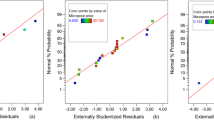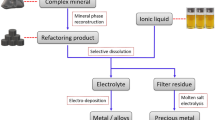Abstract
Rice husk is one of the agricultural by-products that is found abundantly around the world. After utilization of its organic matters as a source of energy in the combustion process, the remaining ash is rich in silica, which is a valuable precursor for production of silica materials. In this study, in the first step, the extraction of silica from rice husk was optimized by leaching with four acids of HCl, HNO3, H2SO4, and H3PO4, and in the second and third step, the mesoporous silica MCM–41 and the magnetic mesoporous silica MCM–41 (magMCM–41) were produced by the extracted silica. The produced materials were characterized by the XRF, XRD, FT-IR, N2 adsorption–desorption, VSM (vibrating sample magnetometry), TGA, SEM, and TEM analyses. The results of XRF analysis showed that the silica was extracted by 95.48% purity by leaching with HCl. The XRD and TEM analyses results revealed that the magMCM–41 was produced with a highly ordered hexagonal structure. The results of N2 adsorption–desorption analysis indicated that the magMCM–41 specific surface area, total pore volume, average pore diameter, and wall thickness were 695.7 m2 g−1, 0.65 cm3 g−1, 2.71 nm, and 1.59 nm, respectively. The magnetic property of the magMCM–41 was determined to be 10.61 emu g−1 at optimum conditions by the VSM analysis. The results of TGA analysis proved the thermal stability of the magMCM–41 by low total weight loss of 1.97%.








Similar content being viewed by others
References
Srivastava A, Singh SK (2020) Utilization of alternative sand for preparation of sustainable mortar: a review. J Clean Prod 253:119706
Rajeswari, A., et al. (2020) 9 - Characterization studies of polymer-based composites related to functionalized filler-matrix interface, Interfaces in Particle and Fibre Reinforced Composites p. 219–250
Mirmohamadsadeghi S, Karimi K (2020) Chapter 21 - Recovery of silica from rice straw and husk. In: Varjani S et al (eds) Current Developments in Biotechnology and Bioengineering. Elsevier, pp 411–433
Le NH et al (2020) Photo-induced generation of size controlled au nanoparticles on pure siliceous ordered mesoporous silica for catalytic applications. Microporous Mesoporous Mater 295:109952
Nuaklong P et al (2020) Influence of rice husk ash on mechanical properties and fire resistance of recycled aggregate high-calcium fly ash geopolymer concrete. J Clean Prod 252:119797
Dominic M et al (2020) Green tire technology: effect of rice husk derived nanocellulose (RHNC) in replacing carbon black (CB) in natural rubber (NR) compounding. Carbohydr Polym 230:115620
Chun J et al (2020) Synthesis of ordered mesoporous silica with various pore structures using high-purity silica extracted from rice husk. J Ind Eng Chem 81:135–143
Al Soubaihi RM et al (2020) Synthesis of hierarchically porous silica aerogel supported palladium catalyst for low-temperature CO oxidation under ignition/extinction conditions. Microporous Mesoporous Mater 292:109758
Başgöz Ö, Güler Ö (2020) The unusually formation of porous silica nano-stalactite structure by high temperature heat treatment of SiO2 aerogel synthesized from rice hull. Ceram Int 46(1):370–380
Hossain SS, Roy PK (2020) Waste rice husk ash derived sol: a potential binder in high alumina refractory castables as a replacement of hydraulic binder. J Alloys Compd 817:152806
Hossain SS et al (2020) A comparative study of physico-mechanical, bioactivity and hemolysis properties of pseudo-wollastonite and wollastonite glass-ceramic synthesized from solid wastes. Ceram Int 46(1):833–843
Pant P et al. (2020) Curcumin loaded silica nanoparticles and their therapeutic applications: a review. J Mat NanoSci 7(1):1–18
Hossain SS et al (2019) A facile route for the preparation of silica foams using rice husk ash. Int J Appl Ceram Technol 16(3):1069–1077
Nassar MY, Ahmed IS, Raya MA (2019) A facile and tunable approach for synthesis of pure silica nanostructures from rice husk for the removal of ciprofloxacin drug from polluted aqueous solutions. J Mol Liq 282:251–263
Yu X et al (2020) KOH-activated hydrochar with engineered porosity as sustainable adsorbent for volatile organic compounds. Colloids Surf A Physicochem Eng Asp 588:124372
Corrente N, Dobrzanski CD, Gor GY (2020) Compressibility of supercritical methane in nanopores: a molecular simulations study. Energy Fuel
Ghorbani F et al (2020) Optimization and modeling of aqueous Cr(VI) adsorption onto activated carbon prepared from sugar beet bagasse agricultural waste by application of response surface methodology. Surf Interfaces 18:100444
Ghorbani F, Kamari S (2019) Core–shell magnetic nanocomposite of Fe3O4@SiO2@NH2 as an efficient and highly recyclable adsorbent of methyl red dye from aqueous environments. Environ Technol Innov 14:100333
Kamari S, Shahbazi A (2020) Biocompatible Fe3O4@SiO2-NH2 nanocomposite as a green nanofiller embedded in PES–nanofiltration membrane matrix for salts, heavy metal ion and dye removal: long–term operation and reusability tests. Chemosphere 243:125282
Kheshti Z et al (2020) Investigating the high gradient magnetic separator function for highly efficient adsorption of lead salt onto magnetic mesoporous silica microspheres and adsorbent recycling. Chem Eng Process Process Intensif 148:107770
Liu X et al (2020) Confining Mo-activated CoSx active sites within MCM-41 for highly efficient dye-sensitized photocatalytic H2 evolution. J Colloid Interface Sci 563:112–121
Alkafajy AM, Albayati TM (2020) High performance of magnetic mesoporous modification for loading and release of meloxicam in drug delivery implementation. Mater Today Commun 23:100890
Kamari S, Ghorbani F (2017) Synthesis of magMCM-41 with rice husk silica as cadmium sorbent from aqueous solutions: parameters’ optimization by response surface methodology. Environ Technol 38(12):1562–1579
Sanati AM, Kamari S, Ghorbani F (2019) Application of response surface methodology for optimization of cadmium adsorption from aqueous solutions by Fe3O4@SiO2@APTMS core–shell magnetic nanohybrid. Surf Interfaces 17:100374
Kamari S, Ghorbani F, Sanati AM (2019) Adsorptive removal of lead from aqueous solutions by amine–functionalized magMCM-41 as a low–cost nanocomposite prepared from rice husk: modeling and optimization by response surface methodology. Sustain Chem Pharm 13:100153
Ghorbani F, Sanati AM, Maleki M (2015) Production of silica nanoparticles from rice husk as agricultural waste by environmental friendly technique. Environ Stud Persian Gulf 2(1):56–65
Wong, Y.S., W.H. Kwan, and M. Lim (2019) Enhancing pozzolanic properties of rice husk ash using acid leaching treatment. AIP Conference Proceedings 2157(1): 020027
Liu F et al (2020) Mineralogical phase separation and leaching characteristics of typical toxic elements in Chinese lignite fly ash. Sci Total Environ 708:135095
Laird M et al (2020) Single-template periodic mesoporous organosilica with organized bimodal mesoporosity. Microporous Mesoporous Mater 297:110042
Ferrero GO et al (2020) Alternatives to rethink tomorrow: biodiesel production from residual and non-edible oils using biocatalyst technology. Renew Energy 150:128–135
Guo X et al (2020) Tuning biodegradability and biocompatibility of mesoporous silica nanoparticles by doping strontium. Ceram Int
Chai PV et al (2017) Preparation of novel polysulfone-Fe3O4/GO mixed-matrix membrane for humic acid rejection. J Water Process Eng 15:83–88
Brasil H et al (2020) Preparation of novel mesoporous Ca/P MCM-41-based materials for mechanochemical diphenyl sulfide oxidation. Microporous Mesoporous Mater 297:110017
Timofeeva MN et al (2020) Effect of the acid activation on a layered titanosilicate AM-4: the fine-tuning of structural and physicochemical properties. Appl Clay Sci 186:105445
Radica F et al (2020) Phenyl-modified hybrid organic-inorganic microporous films as high efficient platforms for styrene sensing. Microporous Mesoporous Mater 294:109877
Tiliakos A et al (2020) Laser-induced graphene as the microporous layer in proton exchange membrane fuel cells. Appl Surf Sci 504:144096
Nassar MY, Ahmed IS, Hendy HS (2018) A facile one-pot hydrothermal synthesis of hematite (α-Fe2O3) nanostructures and cephalexin antibiotic sorptive removal from polluted aqueous media. J Mol Liq 271:844–856
Nassar MY, Moustafa MM, Taha MM (2016) Hydrothermal tuning of the morphology and particle size of hydrozincite nanoparticles using different counterions to produce nanosized ZnO as an efficient adsorbent for textile dye removal. RSC Adv 6(48):42180–42195
Molaei S, Ghadermazi M (2020) Selective and efficient oxidation of sulfides and thiols to their corresponding sulfoxides and disulfides catalyzed with praseodymium (III) and dysprosium (III) isonicotinamide (INA) complexes grafted onto modified mesoporous MCM-41. Solid State Sci 100:106091
Panagiotaki KN et al (2020) Non-porous phosphonated ionic silica nanospheres as nanocarriers for efficient intracellular delivery of doxorubicin. Mater Today Commun 23:100787
Malek NNA, Jawad AH, Abdulhameed AS, Ismail K, Hameed BH (2020) New magnetic Schiff’s base-chitosan-glyoxal/fly ash/Fe3O4 biocomposite for the removal of anionic azo dye: an optimized process. Int J Biol Macromol 146:530–539
Heidari A, Younesi H, Mehraban Z (2009) Removal of Ni(II), Cd(II), and Pb(II) from a ternary aqueous solution by amino functionalized mesoporous and nano mesoporous silica. Chem Eng J 153(1–3):70–79
Oshima S et al (2006) Adsorption behavior of cadmium(II) and Lead(II) on mesoporous silicate MCM-41. Sep Sci Technol 41(8):1635–1643
Rostamizadeh S et al (2013) Amino acid-based ionic liquid immobilized on α-Fe2O3-MCM-41: an efficient magnetic nanocatalyst and recyclable reaction media for the synthesis of quinazolin-4(3H)-one derivatives. J Mol Catal A Chem 374–375:102–110
Chen X, Lam KF, Yeung KL (2011) Selective removal of chromium from different aqueous systems using magnetic MCM-41 nanosorbents. Chem Eng J 172(2–3):728–734
Li S et al (2020) Synthesis of oxidized pullulan coated mesoporous silica for pH-sensitive drug delivery. Eur Polym J 122:109399
Qi Z et al (2020) Microwave-assisted synthesis of CuC2O4·xH2O for anode materials in lithium-ion batteries with a high capacity. Ionics 26(1):33–42
Esmaeili S et al (2020) Synthesis, characterization and photocatalytic studies of MCM-41 mesoporous silica core-shells doped with selenium oxide and lanthanum ions. Microporous Mesoporous Mater 292:109714
Rout L et al (2020) Rational design of thermoresponsive functionalized MCM-41 and their decoration with bimetallic Ag–Pd nanoparticles for catalytic application. Microporous Mesoporous Mater 291:109711
Vaysipour S, Rafiee Z, Nasr-Esfahani M (2020) Synthesis and characterization of copper (II)-poly(acrylic acid)/M-MCM-41 nanocomposite as a novel mesoporous solid acid catalyst for the one-pot synthesis of polyhydroquinoline derivatives. Polyhedron 176:114294
Imoisili PE, Ukoba KO, Jen T-C (2020) Green technology extraction and characterisation of silica nanoparticles from palm kernel shell ash via sol–gel. J Mater Res Technol 9(1):307–313
Si Z et al (2020) A high-permeance organic solvent nanofiltration membrane via covalently bonding mesoporous MCM-41 with polyimide. Sep Purif Technol:116545
Maleki A et al (2020) Palladium-decorated o-phenylenediamine-functionalized Fe3O4/SiO2 magnetic nanoparticles: a promising solid-state catalytic system used for Suzuki–Miyaura coupling reactions. J Phys Chem Solids 136:109200
Ursachi I, Stancu A, Vasile A (2012) Magnetic α-Fe2O3/MCM-41 nanocomposites: preparation, characterization, and catalytic activity for methylene blue degradation. J Colloid Interface Sci 377(1):184–190
Ruffel L et al (2020) Ibuprofen loading into mesoporous silica nanoparticles using co-spray drying: a multi-scale study. Microporous Mesoporous Mater 291:109689
Acknowledgments
The authors wish to thank the University of Kurdistan (UOK) that has financed this research work.
Author information
Authors and Affiliations
Corresponding author
Additional information
Publisher’s Note
Springer Nature remains neutral with regard to jurisdictional claims in published maps and institutional affiliations.
Rights and permissions
About this article
Cite this article
Kamari, S., Ghorbani, F. Extraction of highly pure silica from rice husk as an agricultural by-product and its application in the production of magnetic mesoporous silica MCM–41. Biomass Conv. Bioref. 11, 3001–3009 (2021). https://doi.org/10.1007/s13399-020-00637-w
Received:
Revised:
Accepted:
Published:
Issue Date:
DOI: https://doi.org/10.1007/s13399-020-00637-w




